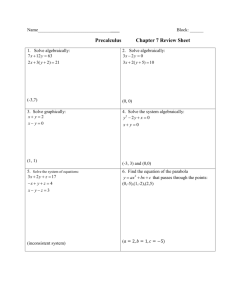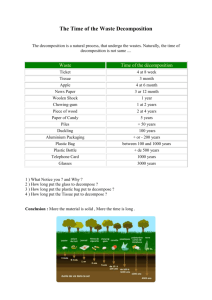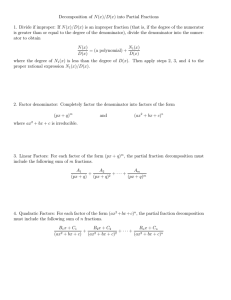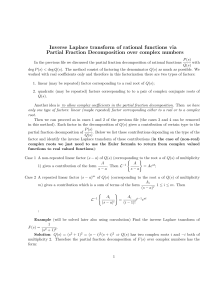10.5 Partial Fraction Decomposition Day 2
advertisement
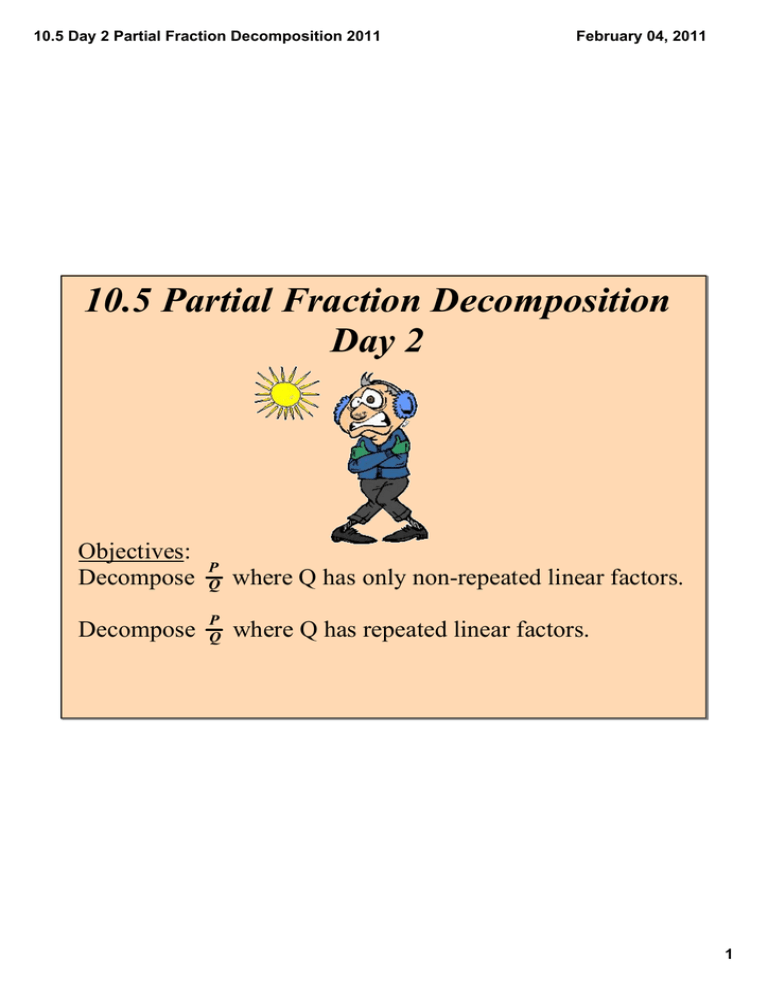
10.5 Day 2 Partial Fraction Decomposition 2011
February 04, 2011
10.5 Partial Fraction Decomposition
Day 2
Objectives: P
Decompose where Q has only non­repeated linear factors.
Q
P
Decompose where Q has repeated linear factors.
Q
1
10.5 Day 2 Partial Fraction Decomposition 2011
February 04, 2011
Warm­up
1. Find the sum.
3
2
+
x + 4
x ­ 3
2
10.5 Day 2 Partial Fraction Decomposition 2011
February 04, 2011
3
10.5 Day 2 Partial Fraction Decomposition 2011
February 04, 2011
What is partial fraction decomposition?
3
2
+
x + 4
x ­ 3
=
=
partial fractions
=
3(x ­ 3)+ 2(x + 4)
(x + 4)(x ­ 3)
3x ­ 9 + 2x + 8
(x + 4)(x ­ 3)
5x ­ 1
x2 + x ­ 12
Partial Fraction Decomposition: Starting with a rational expression and writing it as a sum or difference of two simpler fractions.
(The reverse procedure of this problem.)
4
10.5 Day 2 Partial Fraction Decomposition 2011
February 04, 2011
When are we going to use this???
CALCULUS
5
10.5 Day 2 Partial Fraction Decomposition 2011
We will start with a proper rational expression.
Important facts about Q:
Q ≠ 0
February 04, 2011
P
Q
Q will contain one or both of the following factors.
1. Linear factors of the form x ­ a.
2. Irreducible quadratic factors of the form ax2 + bx + c.
Note: In both cases, a, b, and c are real numbers.
In case 2, a ≠ 0 and b2­4ac < 0 showing it can't be factored.
6
10.5 Day 2 Partial Fraction Decomposition 2011
February 04, 2011
Case #1
P
Decompose where Q has only non­repeated linear factors.
Q
x + 4
x2 ­ 5x + 6
Step 1: Factor the denominator.
x + 4
(x ­ 2)(x ­ 3)
Step 2: Write as the sum of two fractions.
x + 4
= A + B
x ­ 2
x ­ 3
(x ­ 2)(x ­ 3)
7
10.5 Day 2 Partial Fraction Decomposition 2011
Case #1
February 04, 2011
x
x2 ­ 5x + 6
P
Decompose where Q has only non­repeated linear factors.
Q
Step 3: Multiply both sides by the common denominator.
x + 4
(x ­ 2)(x ­ 3)
= A + B (x ­ 2)(x ­ 3)
(x ­ 2)(x ­ 3)
x ­ 3
x ­ 2
x + 4 = A(x ­ 3) + B(x ­ 2)
Step 4: Plug factors of the denominator in for x to solve for A and B. x = 3
x = 2
3 + 4 = A(3 ­ 3) + B(3 ­ 2)
2 + 4 = A(2 ­ 3) + B(2 ­ 2)
7 = A(0) + B(1)
6 = A(­1) + B(0)
7 = B(1)
6 = A(­1)
B = 7
A = ­6
8
10.5 Day 2 Partial Fraction Decomposition 2011
Case #1
February 04, 2011
x
x2 ­ 5x + 6
P
Decompose where Q has only non­repeated linear factors.
Q
Step 5: Write the partial fraction decomposition. (AND CHECK) x + 4
B
A = ­6
= A +
(x ­ 2)(x ­ 3)
x ­ 3
x ­ 2
B = 7
x + 4
= ­6 + 7
(x ­ 2)(x ­ 3)
x ­ 3
x ­ 2
CHECK
­6
7
+
x ­ 2
x ­ 3
9
10.5 Day 2 Partial Fraction Decomposition 2011
February 04, 2011
Case #2
P
Decompose where Q has repeated linear factors.
Q
x + 2
x3 ­ 2x2 + x
Step 1: Factor the denominator.
x + 2
x + 2
x + 2
=
=
x(x2 ­ 2x + 1)
x(x ­ 1)(x ­ 1)
x(x ­ 1)2
Step 2: Write as the sum of three fractions.
C
x + 2
A + B
+
= x(x ­ 1)2
x
x ­ 1 (x ­ 1)2
10
10.5 Day 2 Partial Fraction Decomposition 2011
February 04, 2011
x + 2
x3 ­ 2x2 + x
P
Decompose where Q has repeated linear factors.
Q
Case #2
Step 3: Multiply both sides by the common denominator.
C
2
A + B +
= ­ 1)
x
(
x
x(x ­ 1)2 x(x x + 2
2
­ 1)2
x ­ 1 (x ­ 1)
x
x + 2 = A(x ­ 1)2 + Bx(x ­ 1) + Cx
11
10.5 Day 2 Partial Fraction Decomposition 2011
February 04, 2011
x + 2
x3 ­ 2x2 + x
P
Decompose where Q has repeated linear factors.
Q
Case #2
Step 4: Plug factors of the denominator in for x to solve for A, B & C.
x + 2 = A(x ­ 1)2 + Bx(x ­ 1) + Cx
x = 0 0 + 2 = A(0 ­ 1)2 + B(0)(0 ­ 1) + C(0)
2 = A(­ 1)2 A = 2
x = 1 1 + 2 = A(1 ­ 1)2 + B(1)(1 ­ 1) + C(1)
3 = C(1) C = 3
YOU CAN PLUG IN ANY OTHER NUMBER WITH THE PREVIOUS ANSWERS TOO!
x = 2 2 + 2 = A(2 ­ 1)2 + B(2)(2 ­ 1) + C(2)
4 = A(1)2 + B(2)(1) + C(2)
4 = 2(1)2 + B(2)(1) + 3(2)
4 = 2 + 2B + 6
4 = 2B + 8
2B = ­4
B = ­2 A = 2
B = ­2
C = 3
12
10.5 Day 2 Partial Fraction Decomposition 2011
February 04, 2011
x + 2
x3 ­ 2x2 + x
P
Decompose where Q has repeated linear factors.
Q
Case #2
Step 5: Write the partial fraction decomposition. C
x + 2
A + B +
= 2
x(x ­ 1)2
x ­ 1 (x ­ 1)
x
3
2
­2
x + 2
+
+
2 = (x ­ 1)2
x
x ­ 1
x(x ­ 1)
A = 2
B = ­2
C = 3
13
10.5 Day 2 Partial Fraction Decomposition 2011
February 04, 2011
HOMEWORK
page 792
(13, 14, 17 ­ 20, 23 ­ 26, 31 ­ 33, 43)
14
10.5 Day 2 Partial Fraction Decomposition 2011
February 04, 2011
Case #1 (alternative steps 4 ­ 6)
P
Decompose where Q has only non­repeated linear factors.
Q
x + 4
x2 ­ 5x + 6
Step 1: Factor the denominator.
x + 4
(x ­ 2)(x ­ 3)
Step 2: Write as the sum of two fractions.
x + 4
= A + B
x ­ 2
x ­ 3
(x ­ 2)(x ­ 3)
15
10.5 Day 2 Partial Fraction Decomposition 2011
February 04, 2011
Case #1 (alternative steps 4 ­ 6)
x
x2 ­ 5x + 6
P
Decompose where Q has only non­repeated linear factors.
Q
Step 3: Multiply both sides by the common denominator.
x + 4
(x ­ 2)(x ­ 3)
= A + B (x ­ 2)(x ­ 3)
(x ­ 2)(x ­ 3)
x ­ 3
x ­ 2
x + 4 = A(x ­ 3) + B(x ­ 2)
x + 4 = Ax ­ 3A + Bx ­ 2B
Step 4: Write a system from the like powers of x.
{
x = Ax + Bx 4 = ­ 3A ­ 2B
simplified
{
1 = A + B 4 = ­ 3A ­ 2B
16
10.5 Day 2 Partial Fraction Decomposition 2011
February 04, 2011
Case #1 (alternative steps 4 ­ 6)
x
x2 ­ 5x + 6
P
Decompose where Q has only non­repeated linear factors.
Q
Step 5: Solve the system.
{
1 = A + B 4 = ­ 3A ­ 2B
{
(1 = A + B)(3)
4 = ­ 3A ­ 2B
{
3 = 3A + 3B 4 = ­ 3A ­ 2B
7 = B
1 = A + B 1 = A + 7
A = ­6
Step 6: Write the partial fraction decomposition. (AND CHECK)
x + 4
= A + B
(x ­ 2)(x ­ 3)
x ­ 2
x ­ 3
x + 4
= ­6 + 7
x ­ 2
x ­ 3
(x ­ 2)(x ­ 3)
CHECK
­6
7
+
x ­ 2
x ­ 3
17
